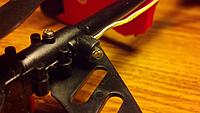Comments (31)
Add Comment
-
 Views: 248
Views: 248
Stock motor in place. Note motor connection at rear of receiver board - red/black wires with caulk holding connection in place. -
 Views: 266
Views: 266
Brushless motor in place. -
 Views: 299
Views: 299
ESC can just be seen under receiver sitting at an angle. Receiver battery cable is connected to the ESC cable, and orange signal wire is connected to the starboard motor power connection pin.
-
 Views: 565
Views: 565
2S balance tap extension wire and Velcro strip for battery -
 Views: 571
Views: 571
Battery in place -
 Views: 575
Views: 575
Alarm (secured with Velcro on back) -
 Views: 517
Views: 517
Recycled Auldey Exploiter blinking red LED tail light -
 Views: 536
Views: 536
Recycled Auldey Exploiter canopy stud -
 Views: 806
Views: 806
Heli-Factor rotor head, blade grip, and swash plate (assembled) -
 Views: 533
Views: 533
Where it all lives - Stanley 3 in 1 Rolling Workshop ($35 USD at Lowe's) Tool box w/removable tool tray on top (V912, Tx, and LiPo battery charger inside below tool tray) Parts container in middle Large wheeled tote on bottom (future power station) -
 Views: 543
Views: 543
Added shrink tubing to servo arm to reduce play between arm and push rod




 can)
can)



